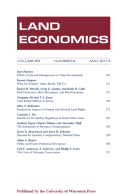
LAND ECONOMICS
Scope & Guideline
Transforming Understanding of Land and Resources
Introduction
Aims and Scopes
- Economic Valuation of Land and Resources:
Research often centers around the economic valuation of land, natural resources, and environmental amenities, using methods such as contingent valuation, hedonic pricing, and discrete choice experiments to assess public preferences and willingness to pay. - Impact of Environmental Policies:
The journal frequently investigates the effects of environmental regulations and policies on land use, agricultural practices, and community welfare, examining how these regulations influence economic behavior and land management decisions. - Land Use and Property Rights:
A significant focus is placed on the role of property rights and land use regulations in shaping economic outcomes, including studies on land tenure systems, land markets, and the implications of property rights on environmental conservation. - Socio-Economic Factors in Land Economics:
Research also addresses socio-economic factors influencing land use decisions, such as income elasticity, demographic changes, and community responses to environmental challenges, highlighting the interplay between economic conditions and land management. - Sustainability and Ecosystem Services:
The journal emphasizes sustainability and the valuation of ecosystem services, exploring how land management practices can be aligned with economic incentives to promote environmental sustainability and community resilience.
Trending and Emerging
- Climate Change and Adaptation Studies:
Research addressing the impacts of climate change on land use and economic behavior is increasingly prominent. This includes studies on adaptation strategies for agriculture and urban planning in response to climate risks. - Intersection of Technology and Land Use:
There is a rising focus on how technology, including data analytics and machine learning, can inform land use decisions and enhance environmental management, indicating a shift towards more data-driven approaches. - Social Equity in Environmental Policies:
Emerging themes include the examination of social equity in land use and environmental policies, particularly how these policies affect marginalized communities and the role of public engagement in environmental decision-making. - Urbanization and Land Use Dynamics:
Research on urbanization and its effects on land use patterns, property values, and community dynamics is becoming more prevalent, reflecting the growing importance of urban studies within land economics. - Health and Environmental Linkages:
The connections between environmental quality, land use, and public health are increasingly being explored, highlighting the importance of land economics in addressing health disparities linked to environmental factors.
Declining or Waning
- Traditional Agricultural Economics:
Research specifically focused on traditional agricultural economics, such as crop production efficiency and yield analysis, has seen a decline. This shift may be due to a growing emphasis on integrating environmental concerns and sustainability into land economics. - Static Land Use Models:
There appears to be a waning interest in static models of land use that do not account for dynamic changes in policy and environmental conditions. Researchers are increasingly favoring more complex, adaptive models that incorporate uncertainty and variability. - Generalized Environmental Impact Assessments:
General assessments of environmental impacts without specific economic implications have decreased in frequency. There is a trend towards more nuanced studies that integrate economic valuation techniques with environmental assessments.
Similar Journals

Trees Forests and People
Innovating Solutions for Forest Conservation and Community EngagementTrees, Forests and People is an esteemed peer-reviewed journal published by Elsevier that commenced its journey in 2020 and focuses on the intricate relationships between trees, forests, and human communities. With its E-ISSN of 2666-7193, this journal serves as a vital platform for presenting cutting-edge research in disciplines such as forestry, environmental science, and management. Recognized for its impact within the academic community, it has achieved a prestigious Q1 ranking in both Economics, Econometrics and Finance (Miscellaneous) and Forestry, alongside a Q2 ranking in Management, Monitoring, Policy and Law as of 2023. Its Scopus rankings indicate robust positioning in various fields, appealing to a diverse audience of researchers, professionals, and policy-makers engaged in sustainable forest management and ecosystem services. By offering open access options, the journal ensures that critical findings are readily available to a global audience, fostering knowledge sharing and collaborative efforts aimed at addressing the pressing challenges in forest conservation and management.

MONTANA-THE MAGAZINE OF WESTERN HISTORY
Illuminating the Cultural Legacy of the American WestMONTANA-THE MAGAZINE OF WESTERN HISTORY is a distinguished publication that delves into the rich tapestry of Western American history, providing a platform for scholarship that encompasses the cultural, social, and environmental narratives of the region. Published by the MONTANA HISTORICAL SOCIETY, this journal serves as a vital resource for researchers, historians, and enthusiasts alike, chronicling significant events and figures that shape Montana and its surrounding areas. With an ISSN of 0026-9891 and an E-ISSN of 2328-4293, the journal's archives span numerous converged years, showcasing a depth of inquiry and scholarship from 1971 through 2024. Although categorized in the fourth quartile (Q4) of History in 2023, MONTANA continues to foster meaningful discussions that advance our understanding of the past. The journal is particularly valuable for students and professionals seeking insights into historical contexts that inform contemporary issues. While it is not open access, its contributions remain significant for expanding knowledge and promoting the history of the American West.
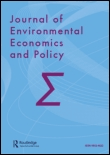
Journal of Environmental Economics and Policy
Bridging the Gap between Environmental Challenges and Economic PoliciesThe Journal of Environmental Economics and Policy, published by Routledge Journals, Taylor & Francis Ltd, serves as a premier platform for researchers, policymakers, and scholars focused on the interlinkages between environmental issues and economic principles. With an ISSN of 2160-6544 and an E-ISSN of 2160-6552, this esteemed journal has achieved a commendable positioning in the academic community, securing a Q2 rating in key fields such as Economics and Econometrics, Environmental Science, and Management, Monitoring, Policy, and Law as of 2023. The journal has consistently been ranked in the upper tiers of its categories, reflecting its impact and relevance in contemporary environmental discussions. Operating from the United Kingdom, this journal is dedicated to publishing high-quality research articles, reviews, and case studies that contribute to the understanding of economic strategies in environmental governance and policy-making. With an address at 2-4 Park Square, Milton Park, Abingdon OX14 4RN, Oxon, England, it invites contributions that address pressing ecological challenges through an economic lens, fostering an interdisciplinary dialogue crucial for sustainable development. Although not an open access journal, it remains influential in shaping policies and practices that align economic growth with environmental sustainability.

Bulletin of Geography-Physical Geography Series
Illuminating the complexities of our physical world.The Bulletin of Geography-Physical Geography Series is a prominent open-access journal dedicated to advancing the field of physical geography. Published by Nicolaus Copernicus University in Poland, this journal has been a vital resource for researchers, professionals, and students alike since its inception in 2009. With an ISSN of 2080-7686 and an E-ISSN of 2300-8490, it contributes significantly to the academic discourse in geography, planning and development, and geophysics, boasting a 2023 Scopus rank of #385 in Social Sciences and #84 in Earth and Planetary Sciences. The journal aims to disseminate innovative research and critical insights that address contemporary challenges in physical geography, making it a valuable platform for those seeking to contribute to or stay informed about the latest developments in the field. With its commitment to quality and accessibility, the Bulletin of Geography-Physical Geography Series plays a crucial role in fostering scholarly exchange and collaboration globally.
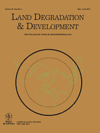
LAND DEGRADATION & DEVELOPMENT
Bridging the gap between science and sustainable development.LAND DEGRADATION & DEVELOPMENT is a premier academic journal published by WILEY that has been at the forefront of research on the critical issues surrounding land degradation since its inception in 1989. With an impressive impact factor and ranked in the Q1 category across multiple fields including Development, Environmental Chemistry, Environmental Science, and Soil Science, this journal serves as an essential resource for scholars and professionals dedicated to sustainable land management and environmental conservation. Although it currently does not provide open access, its rigorous peer-review process ensures the publication of high-quality, impactful research that addresses vital environmental challenges. The journal aims to foster interdisciplinary collaboration, promote innovative solutions, and disseminate knowledge that not only informs policy but also empowers communities to combat land degradation effectively. Researchers, professionals, and students alike will find the insights and findings published in LAND DEGRADATION & DEVELOPMENT invaluable for advancing their understanding and practices within this critical field.

Geography and Sustainability
Championing Innovative Insights in Sustainability Science.Geography and Sustainability is a prestigious, peer-reviewed journal published by Elsevier, focusing on the interdisciplinary fields of geography, ecology, and environmental science. As an Open Access publication since 2020, it aims to provide a platform for the dissemination of high-quality research that addresses critical sustainability challenges facing our planet. Based in China, the journal navigates through an impressive array of categories, all classified in the Q1 Quartile rankings for 2023, showcasing its top-tier status in areas such as Earth-Surface Processes, Geography, Planning and Development, and Nature and Landscape Conservation. With its notable impact factors—ranked 2nd in Earth and Planetary Sciences and 3rd in Environmental Science—it attracts contributions from leading experts and emerging scholars alike. Researchers, professionals, and students seeking to advance the scientific understanding of sustainability and its geographical implications will find indispensable resources and innovative findings within the pages of this journal.

Carpathian Journal of Earth and Environmental Sciences
Bridging Disciplines for Environmental SolutionsCarpathian Journal of Earth and Environmental Sciences is a distinguished academic journal dedicated to advancing the interdisciplinary field of Earth and environmental sciences. Published by the Carpathian Association for Environment and Earth Sciences, this journal plays a pivotal role in disseminating high-quality research focused on the dynamic interactions between geological processes and environmental changes. With an ISSN of 1842-4090 and an E-ISSN of 1844-489X, the journal is indexed in Scopus and holds an esteemed Q3 quartile ranking in both Earth and Planetary Sciences and Environmental Science categories as of 2023. Since its inception in 2008, the Carpathian Journal has provided an open access platform for researchers, professionals, and students to share insights, foster collaboration, and engage in critical discussions on pressing environmental issues. By continuously contributing to the body of knowledge in this field, the journal not only enhances academic discourse but also promotes sustainable environmental practices across Romania and beyond.
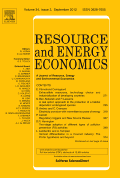
RESOURCE AND ENERGY ECONOMICS
Advancing Knowledge in Resource ManagementRESOURCE AND ENERGY ECONOMICS is a premier academic journal published by ELSEVIER, specializing in the intricate fields of economics and econometrics with a particular focus on the intersection of resource management and energy policy. Established in 1993, the journal has been a vital platform for scholars and professionals, contributing to significant advancements in the understanding of economic aspects surrounding natural resources and energy systems. With an impressive impact factor and ranking in the top quartile (Q1) of its category, it is recognized for its rigorous peer-reviewed research that informs both academic inquiry and practical applications in the industry. The journal is based in the Netherlands and caters to a global audience, fostering interdisciplinary discussions aimed at addressing pressing environmental and economic challenges. Accessible primarily through institutional subscriptions, RESOURCE AND ENERGY ECONOMICS continues to shape the discourse in its field, making it an essential read for researchers, policymakers, and practitioners striving for innovative solutions in resource and energy economics.
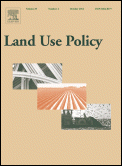
LAND USE POLICY
Innovating Practices for Responsible Land UseLAND USE POLICY, published by ELSEVIER SCI LTD, is a premier academic journal dedicated to advancing the study of land use issues and policies, with a particular focus on sustainable management and conservation practices. Since its inception in 1984, this journal has established itself as an influential platform in the fields of Forestry, Geography, Planning and Development, and Environmental Science, consistently achieving a Q1 category ranking across various disciplines. With an impressive impact factor and recognition as a top-tier source (e.g., ranking #18/821 in Geography and Planning), it serves as a critical resource for researchers, practitioners, and policy-makers looking to address complex land use challenges. Although it does not offer open access, the journal's articles are widely accessible through institutional subscriptions, enhancing its reach. Researchers and students can find valuable insights into innovative policies and methodologies that promote sustainable land management, making LAND USE POLICY essential reading for anyone engaged in environmental studies and policy development.
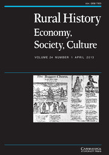
Rural History-Economy Society Culture
Connecting Past and Present: The Essence of Rural Histories.Rural History: Economy Society Culture is a vital academic journal dedicated to exploring the multifaceted aspects of rural history from economic, societal, and cultural perspectives. Published by Cambridge University Press, this journal contributes substantially to the field by presenting innovative research that spans a range of disciplines, including history, geography, and urban studies. With a convergence of scholarship from 1990 through 2024, this journal holds significant rankings in the top quartiles of its categories, particularly excelling in History where it ranks in the Q2 quartile. It also demonstrates respectable positions in other arts and humanities domains, reflecting its considerable impact, especially in history-related studies, where it sits in the 76th percentile. While not open access, it provides valuable insights for researchers, professionals, and students passionate about understanding the dynamics of rural societies and their historical underpinnings. For scholars aiming to contribute to this rich dialogue, Rural History serves as an essential platform for disseminating significant findings and advancing knowledge in the field.